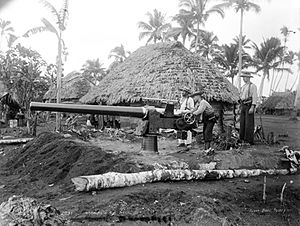Siege of Apia
| Siege of Apia | |||||||
|---|---|---|---|---|---|---|---|
| Part of the Second Samoan Civil War | |||||||
 United States Marines manning a naval gun near Apia in March of 1899. |
|||||||
|
|||||||
| Belligerents | |||||||
|
Allies: |
Supported by: |
||||||
| Commanders and leaders | |||||||
|
|
|
||||||
| Strength | |||||||
|
Land: 2,260 Sea: 3 cruisers 1 corvette |
4,000 | ||||||
| Casualties and losses | |||||||
| 9 killed ~1 wounded |
~27 killed | ||||||
The Siege of Apia, or the Battle of Apia, occurred during the Second Samoan Civil War in March 1899 at Apia. Samoan forces loyal to Prince Tanu were besieged by a larger force of Samoan rebels loyal to Mata'afa Iosefo. Supporting Prince Tanu were landing parties from four British and American warships. Over the course of several days of fighting, the Samoan rebels were defeated.
Followers of Mata'afa Iosefo were known as Mataafans or Mataafanites, they received support from Germany. In January 1899, Prince Tanu was exiled by the Mataafans which provoked a response from the United States Navy and the Royal Navy. Rear Admiral Albert Kautz of the cruiser USS Philadelphia arrived first on March 13 and held a meeting with the many different officials there. When no solution was agreed upon, a shore party was landed and the Mataafa's followers were ordered to leave Apia and go back to their villages. Instead of following this command, the Mataafans removed themselves from town but only to the outskirts where they started evicting the European and American population from their homes. Refugees started fleeing to Apia where they took up houses along the coast, under the protection of naval guns. The British cruiser HMS Porpoise and corvette HMS Royalist were deployed to Apia; sailors and marines from these two vessels were also landed for the protection of the town.
On March 15, Rear Admiral Kautz sent the Mataafa another message, this time he demanded that the Mataafans leave the outskirts of the town. This message was ignored and instead Mata'afa Iosefo increased the numbers of his men around Apia and attacked. The British and American commanders estimated that a total of over 4,000 rebel warriors armed with 2,500 rifles opposed them. Over the course of the siege there were about 260 British and American servicemen involved, fighting with about 2,000 friendly Samoan warriors. Apia referred to the main settlement which was surrounded by several nearby villages. The Americans held the Tivoli Hotel in Apia, which was used as their command post, sentries were also placed at the consulates which were fairly isolated according to reports and mostly surrounded by dense jungle. At 12:30 am, the Mataafans rushed the British and American consulates guarded by sailors and marines under Lieutenant Guy Reginald Archer Gaunt of HMS Porpoise and Captain M. Perkins of the United States Marines. Though the British and Americans held their fire, the Samoans retreated after realizing that Apia's garrison was on high alert and prepared for battle.
...
Wikipedia
